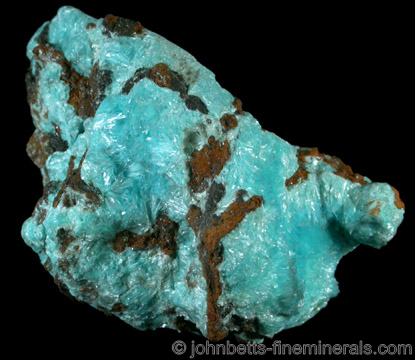The Mineral aurichalcite

Aurichalcite has a beautiful pastel color that is very distinctive. In its most typical form, the tiny fragile crystal needles may rub off when touched, and will often leave a blue residue on a surface. Handling of such specimens should be avoided due to their fragility, and washing Aurichalcite should also be avoided for this reason.
Chemical Formula
(Zn,Cu)5(CO3)2(OH)6
Color
Light blue, sky blue, blue-green, pale green
Crystal System
Orthorhombic
Properties
Streak
Pale blue-green to white |
Hardness
2 |
Transparency
Translucent |
Specific Gravity
3.6 - 4.2 |
Luster
Silky to pearly |
Cleavage
Indiscernible |
Fracture
Uneven |
Tenacity
Slightly flexible and sectile |
Crystal Habits
Most often as a mat of tiny, thin, interwoven needles. Also plumose, as crusts, as thin scales, radiating, botryoidal, and as tiny balls of radiating crystals. Individual crystals, which are very small, are usually elongated, and occasionally tabular.
Uses
Aurichalcite is considered a natural brass ore, since it is composed of zinc and copper, the constituents of brass. However, it occurs too sparingly, and there are no practical methods for brass to be extracted from it. It is, though, an ore of zinc and copper when found in mines where there exists workable deposits of these elements.
Noteworthy Localities
Aurichalcite comes from many of the classic European copper oxidation deposits. These include Chessy, France; Laurium, Greece; the Leadhills of Scotland; and Matlock, Derbyshire and Caldbeck Fells, Cumbria, England. Other European occurrences include Campiglia Marittima, Livorno Province, Tuscany, Italy; and the Rohdenhaus Quarry, Wolfrath, North Rhine-Westphalia, Germany.
Perhaps the best-known Aurichalcite locality is the Ojuela Mine, Mapimi, Durango, Mexico, where it occurs in vibrant acicular tufts, associated with Hemimorphite and Adamite on a brown Limonite matrix. Also from the Ojuela Mine are highly attractive rhombic Calcite crystals with dense, internal inclusions of brightly-colored Aurichalcite.
In the U.S., good Aurichalcite specimens have come primarily from Arizona, at the 79 Mine in Hayden, Gila Co.; the Copper Queen Mine in Bisbee, Cochise Co.; and from the Silver Hill Mine in Pima Co. Other important localities include Magdalena, Soccoro Co., New Mexico; the Hidden Treasure Mine and Stockton, Tooele Co., Utah; and the Keeler Mine, Cottonwood Canyon, Salt Lake Co., Utah. Aurichalcite has also been found in the Grand Deposit Mine of White Pine Co., Nevada; the Darwin District of Inyo Co., California; and the Tin Mountain Mine, Custer Co., South Dakota.
Distingushing Similar Minerals
Malachite - Greener color, usually more compact.